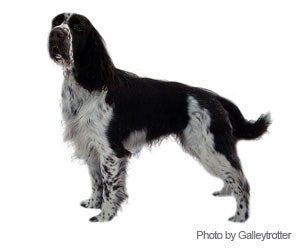English Springer Spaniel
-
Overview
View Grooming Diagram for english springer spanielSpaniels were once born in the same litter. Originally, smaller Cocker Spaniels, medium-sized Field Spaniels and larger Springer Spaniels were all differently-sized dogs from the same litter who were used differently in the field. They were classified by their hunting jobs instead of by breed. Eventually, hunters started to breed the dogs for size and specialized jobs. The largest, fastest and most versatile hunters became the modern Springer Spaniel, who stands up to 21 inches tall and weighs between 40 and 50 pounds.
English Springer Spaniels are incredibly active dogs who require actively involved owners who will groom, exercise and dote on them, both indoors and out.
-
Personality
-
Coat Care

All Springer Spaniels will need to be brushed with a large pin brush or metal comb at least three times a week. Brushing helps the coat lie flat and controls shedding. Begin brushing at the base of your spaniel's coat and brush thoroughly to the end of the hair. Pay special attention to areas around the face, ears and feet.
With preparation, perseverance and a positive attitude, bathing can become a fun and fulfilling part of the regular grooming cycle, while helping your dog avoid many diseases and infections.
The general rule of thumb for dog bathing is every three months but it's generally best to bathe dogs with silky coats more often. The coat should end up fresh smelling, light and shiny, with no loose or shedding hair. First give the dog a good brushing to remove dead hair and mats. Place a rubber mat in the tub to provide secure footing and fill the tub with three to four inches of lukewarm water. Use a spray hose, pitcher or unbreakable cup to wet the dog, taking caution to avoid getting water in the eyes, ears and nose. Massage in pet shampoo, saving the head for last. Immediately rinse thoroughly, starting with the head to prevent soap from dripping into the eyes. Towel dry.
Some owners choose to trim the hair around the head, neck, ears, tail and feet to neaten their English Springer Spaniel's appearance and help them stay comfortable.
Many dog owners are apprehensive about trimming their dog’s nails because they are nervous about cutting into the quick. But with the right conditioning and careful cutting, nail clipping can be a simple, stress-free activity for you and your dog.
Provide your dog with plenty of positive reinforcement and even treats to help associate nail clipping with a positive experience. As you start to clip, gently press on your dog’s paws to help him become accustomed to the feeling of having his nails clipped. Then, work gradually, shaving down just a thin portion of the nail at first to make sure you don’t reach the quick. Clip one nail, reward your dog with a treat, and stop to give him some positive reinforcement before moving on. Gradually increase the number of nails you clip in one sitting to help your dog get used to the process. Never trim extremely long nails down to a short nail in one sitting, because this is an excellent way to accidently quick the dog’s nail. Instead, work gradually, shaving small portions of your dog’s nails off each time.
You can tell if you’re getting close to the quick by the texture of your dog’s nail. The nail is hard closer to the surface and becomes softer as you get closer to the quick. If your dog’s nail starts to feel softer, that’s a good indication that you’re getting close to the quick.
Make sure to check their long ears routinely for debris and infection. Springer Spaniels' long, hairy pendant ears are prone to infection and their active lifestyles mean that their coats and ears can collect lots of dirt outdoors.
Many owners do not realize how important it is to brush your pet’s teeth on a regular basis. Some dogs are prone to dental problems and sensitive teeth, especially small dogs with tiny teeth and dogs with special diets. These problems can be easily combatted with frequent brushing.
Cavities are rare with dogs but gum disease caused by tartar buildup is not, which is why they require regular brushing with toothpaste and a toothbrush formulated specifically for dogs. While daily brushing is ideal, doing so on a weekly basis will be a big help in avoiding the need to bring your dog to a veterinarian for a cleaning, which usually has to be done under sedation.

 India (English)
India (English)
 Middle East and Africa (English)
Middle East and Africa (English)
 South Africa (English)
South Africa (English)
 Australia (English)
Australia (English)
 Japan (日本語)
Japan (日本語)
 South East Asia (English)
South East Asia (English)
 Singapore (English)
Singapore (English)
 Europe (English)
Europe (English)
 United Kingdom (English)
United Kingdom (English)
 Argentina (Español)
Argentina (Español)
 Brazil (Portuguese)
Brazil (Portuguese)
 Colombia (Español)
Colombia (Español)
 Latin America (Español)
Latin America (Español)
 México (Español)
México (Español)
 Chile (Español)
Chile (Español)
 Peru (Español)
Peru (Español)
 Canada (English)
Canada (English)

